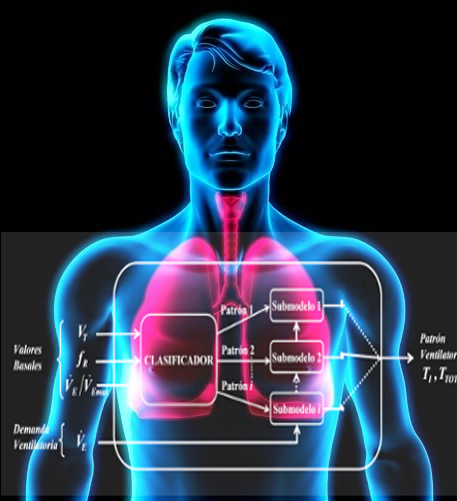M. Hernández, 2007
Analysis of respiratory control system response to pathologies and ventilatory stimuli
By Alher Mauricio Hernández Valdivieso
Directed by Miguel Ángel Mañanas
2007.07.31Summary

This thesis is the initial phase of a research line that has the objective of designing and to evaluate new tools that allow simulating and to predict properly the response of the respiratory system when it is under different stimuli and affected by pathologies with the purpose of analyzing in the future the interaction with different ventilatory modes provided by a simulated mechanical ventilator.
Experimental data of healthy subjects and patients with common respiratory diseases (chronic obstructive pulmonary disease, COPD and restrictive pulmonary disease, RPD) are studied during basal state and during increased breathing demand. The study of breathing pattern in healthy people is made from noninvasive measures, diverse parameters are formulated and studied (muscular and ventilatory) and it is identified which of them are more sensitive to the hypercapnic stimulus. Additionally, different respiratory system models are studied, doing parameter fitting, a comparative study and introducing modifications in order to predict properly the response of the respiratory system in healthy subjects and respiratory patients during increased ventilatory demand. The former is made, introducing nonlinear ventilatory mechanical characteristics in deep respiratory system models and is the main contribution of this thesis, because currently, there is not knowledge about deep respiratory models capable of predicting properly during spontaneous breathing the ventilatory pattern of COPD and RPD patients. In addition, this profit allows to project new studies that lead to the development of tools to help in the decision-making when the mechanical ventilator is formed.
It is evaluated the relation of respiratory parameters obtained of experimental data with work and respiratory cost indexes provided by a model simulating the respiratory pattern of healthy subjects under stimulus of hypercapnia.Parameters from pressure signals allow the estimation of the respiratory work that each subject is making better than parameters from muscular or flow signals.
It is described a practical application of the knowledge and experience acquired modeling the respiratory system by means of the design of a virtual laboratory (RespiLab) and related practical sessions for the teaching of the human respiratory control system function with application in studies of Biomedical Engineering within the framework of the European Space for Higher Education. This virtual laboratory has an educational aim initially, but its applicability can be extended to the field of research and training or learning of therapists and physiologists, constituting the base for the development of new and more complex tools with application in the clinical scope.
TDX Link
Share: